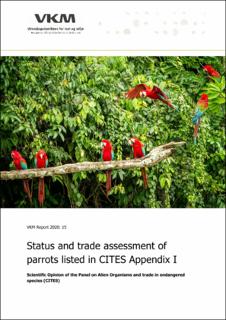| dc.description.abstract | Parrots are one of the most species-rich groups of birds of which the majority inhabits tropical and subtropical forests. Nearly one-third of parrots are threatened with extinction (IUCN categories CR, EN or VU) and more than half of the world’s parrot species are assumed to be decreasing in numbers. Parrots are popular pets on all continents, mainly due to their colourful feathers, their capacity to mimic the human voice, and their tolerance to life in captivity. More than 250 species have been traded internationally. Since the inception of CITES in 1975, trade of about 12 million live wild-sourced parrots has been registered. Currently, 55 parrot species are listed on CITES Appendix I (Norwegian CITES regulation list A) that includes the most endangered among CITES-listed animals and plants. In compliance with CITES, Norway only permits import for commercial purposes of Appendix I listed parrots bred in captivity in operations included in the Secretariat's Register (Resolution Conf. 12.10 (Rev. CoP15). Presently, 9 of the Appendix I parrot species are bred in such facilities. Import of Appendix I species to Norway requires permits both from the exporter’s CITES authority and the Norwegian Environment Agency (Norwegian CITES Management Authority). All legal transactions of CITES Appendix I listed species should be recorded in the UNEP World Conservation Monitoring Centre (UNEP-WCMC) Trade Database. However, discrepancies are common, demonstrating that the trade monitoring is not accurate. Moreover, several studies suggest that regardless of efforts to regulate trade, the global conservation situation for parrots may be worse than estimated by the IUCN species statuses. Even though habitat loss is the main threat to most parrot species, it has been suggested that priority should be given to conservation actions aimed at reducing the illegal capture of wild parrots for the pet trade. As Norway’s CITES Scientific Authority, the Norwegian Scientific Committee for Food and Environment (VKM) was assigned by the Norwegian Environment Agency to assess the status of populations and trade for Appendix I parrot species. Methods: As different trade patterns are typical for different geographic regions, the species were initially divided into three groups: Africa, Australasia and Central and South America. For species with commercial trade registered in the UNEP-WCMC trade database after year 2010 a full assessment was made. In addition, two species for which negative impact from illegal trade is suspected were also fully assessed. The assessments are based on the Norwegian Cites Regulation and Article III of the Convention and Resolution 16.7(Rev.CoP17). Information on the parrot species assessed in this report were gathered from the text accounts published by BirdLife International and Birds of the World as well as literature cited in the text. Results: VKM undertook full assessments of the population status and trade for 26 of the 55 CITES Appendix I species. The species assessments are presented as fact sheets. They each contain a brief summary of the species’ biology (name, taxonomy, distribution, life history, habitat and role in ecosystem), populations and trends, threats and conservation status, population surveillance and regulations, evaluation of legal/illegal trapping and trade, overall assessment of data quality and references. We found that the quantity, as well as quality, of the information available for the Appendix I parrot species varied much. This was the case for data on general biology, population size and trends and levels of illegal trade. For all of the 23 of species for which commercial trade was registered since 2010 in the UNEP-WCMC trade database discrepancies ........ | en_US |
